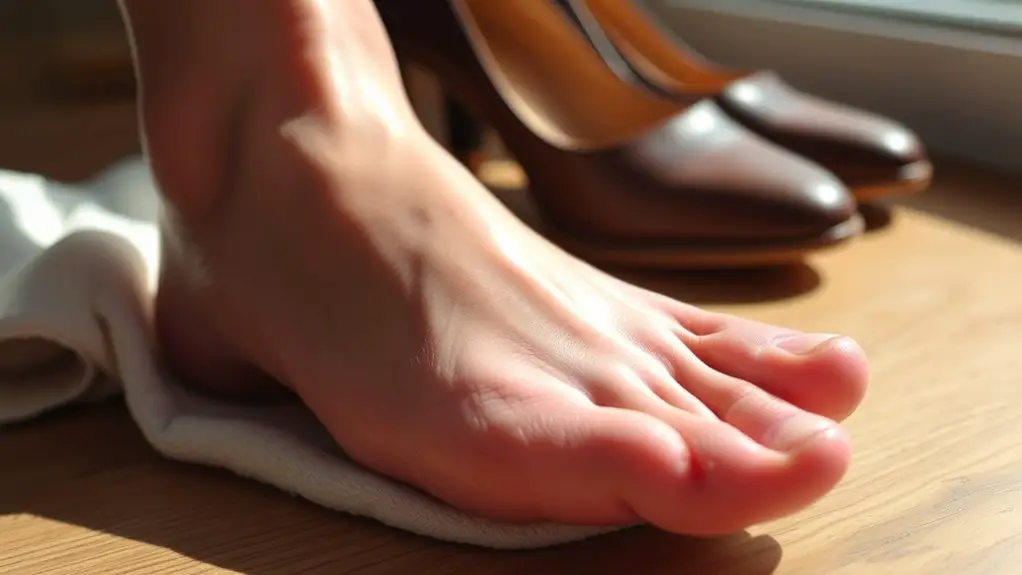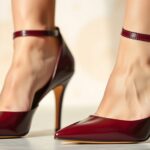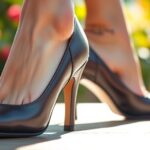To prevent heel blisters on sensitive skin, choose breathable footwear that fits snugly without being tight. Use blister prevention products like pads and gels to reduce friction. Keep your feet dry by applying moisture-absorbing powder and air drying them after washing. Opt for moisture-wicking synthetic socks instead of cotton, and gradually break in new shoes by increasing wear time. By following these guidelines, you’ll manage discomfort effectively. More detailed strategies and tips await you.
Choose the Right Footwear
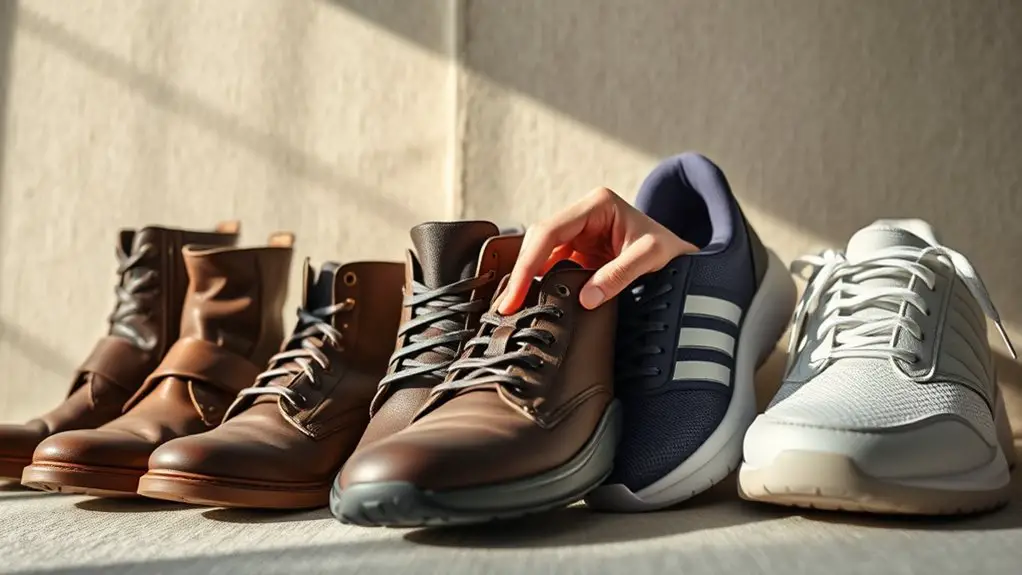
Choosing the right footwear is vital in preventing heel blisters. The shoe materials you select can greatly impact your comfort and skin health. Opt for breathable fabrics that allow moisture to escape, reducing friction against your heels. Avoid rigid materials that can cause excessive rubbing, leading to blisters.
Conducting a fit assessment is important. Make sure your shoes fit snugly without being overly tight, as this can create pressure points. Pay attention to heel height and arch support; shoes that are too loose can cause your foot to slide, while overly tight options may restrict movement. Always try on shoes with the same type of socks you plan to wear, as this affects the overall fit. Remember, the right footwear is not just about style; it’s about preventing injury and guaranteeing comfort during your daily activities. Prioritizing fit and appropriate materials will help keep your heels blister-free.
Use Blister Prevention Products
Even with the right footwear, additional measures can enhance your protection against heel blisters. Utilizing blister prevention products tailored for sensitive skin is vital. These products come in various forms, including blister pads, gels, and specialized socks. Blister pads create a protective barrier, reducing friction between the skin and your shoes. Gels often contain ingredients that soothe irritation, further addressing skin sensitivity.
When selecting these products, consider those specifically designed for blister prevention; they often feature advanced materials that wick moisture and conform to your foot’s shape. It’s essential to apply these products in areas prone to friction, such as the heel, to maximize their efficiency.
Regularly check the condition of the products you use, replacing them as needed to maintain ideal protection. By incorporating these blister prevention strategies, you can greatly reduce your risk of developing painful heel blisters while accommodating your skin sensitivity.
Keep Your Feet Dry
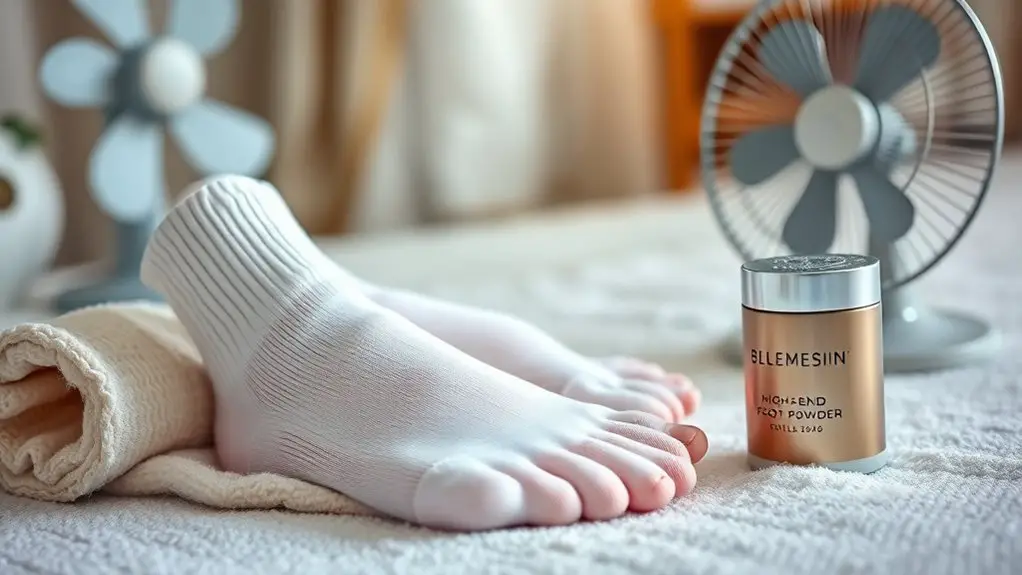
To effectively prevent heel blisters, it is vital to keep your feet dry, as moisture can markedly increase friction and exacerbate skin irritation. Employing proper moisture management techniques is important. Here are some effective foot drying techniques you should consider incorporating into your routine:
| Technique | Description |
|---|---|
| Air Drying | Allow your feet to breathe outdoors for a few minutes after washing. |
| Toweling | Use a soft, absorbent towel to gently pat your feet dry, focusing on the heel area. |
| Foot Powder | Apply a moisture-absorbing foot powder to keep your feet dry throughout the day. |
Wear Moisture-Wicking Socks
Wearing moisture-wicking socks is vital for preventing heel blisters, as they help draw moisture away from your skin. These specialized socks are designed from synthetic sock materials like polyester, nylon, or merino wool, which excel in moisture management. Unlike traditional cotton socks, which retain moisture, these advanced materials transport sweat away from your feet, keeping them dry and reducing friction.
When your feet stay dry, the likelihood of developing blisters decreases considerably. Additionally, moisture-wicking socks often feature cushioning and a snug fit, which enhances comfort and minimizes movement that can lead to irritation. Selecting the right sock thickness can also play an important role; thicker socks may provide more protection while still managing moisture effectively. As a result, investing in quality moisture-wicking socks is a proactive step in maintaining foot health and preventing painful heel blisters, especially if you have sensitive skin.
Gradually Break in New Shoes
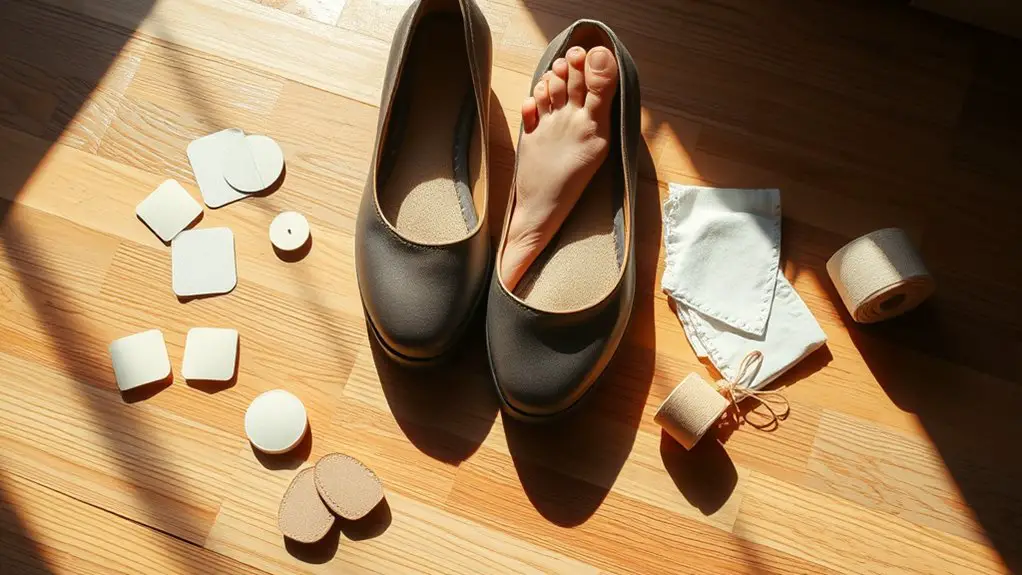
Gradually breaking in new shoes is essential for preventing heel blisters, as it allows your feet to adapt to the fit and structure of the footwear. Employing effective breaking in techniques can enhance shoe flexibility and comfort over time. Start by wearing the new shoes for short periods, progressively increasing the duration.
| Day | Action |
|---|---|
| Day 1 | Wear for 30 minutes indoors |
| Day 2 | Increase to 1 hour |
| Day 3 | Add a 15-minute walk outside |
| Day 4 | Wear for 2 hours, including walking |
| Day 5 | Full day wear with appropriate socks |
These steps allow your feet to become accustomed to the shoes’ contours while minimizing friction. Pay attention to any discomfort, and if necessary, adjust your approach to guarantee a smooth change, ultimately preventing heel blisters.
Protect High-Risk Areas
To prevent heel blisters, it’s essential to identify pressure points on your feet that may be prone to friction. Once you recognize these high-risk areas, you should use protective padding to cushion them effectively. This proactive approach can greatly reduce the likelihood of developing blisters during extended wear.
Identify Pressure Points
Although heel blisters can occur for various reasons, identifying pressure points on your feet is essential for prevention. A sensitivity assessment helps you determine which areas are prone to irritation. Using pressure mapping can further pinpoint high-risk zones, allowing for targeted interventions.
Consider the following pressure points:
- Heel: Often bears the most weight during walking.
- Arch: Can experience excessive friction from footwear.
- Ankle: A common area for rubbing against shoes.
Use Protective Padding
Using protective padding is vital for safeguarding high-risk areas on your feet, particularly in spots identified as pressure points. Various padding types, such as gel, foam, and silicone, are effective in reducing friction and absorbing impact. To guarantee ideal protection, it’s essential to choose the right material based on your specific needs and activity level.
When applying padding, clean and dry the skin to enhance adhesion, then position the padding directly over the pressure point, assuring a snug fit without restricting circulation. For added security, consider using adhesive strips or medical tape to keep the padding in place during movement. By implementing these application techniques, you can considerably reduce the risk of heel blisters and maintain foot health.
Maintain Foot Hygiene and Care
Maintaining proper foot hygiene is essential for preventing heel blisters, as it reduces friction and keeps your skin healthy. Regular foot washing and skin moisturizing are key practices that can considerably diminish the risk of developing blisters.
Proper foot hygiene is crucial for preventing heel blisters by minimizing friction and maintaining healthy skin.
Consider these three important hygiene tips:
- Wash your feet daily: Use mild soap and warm water to clean your feet thoroughly, paying special attention to the heel area.
- Dry your feet properly: After washing, dry your feet completely, especially between the toes, to prevent moisture buildup that can lead to blisters.
- Moisturize regularly: Apply a suitable foot cream to keep your skin hydrated and supple, reducing the likelihood of friction and irritation.
Frequently Asked Questions
Can Certain Foot Shapes Increase the Likelihood of Heel Blisters?
Studies show that 75% of people have foot shapes that can predispose them to blisters. Understanding your foot anatomy is essential for effective blister prevention, as certain shapes create friction and pressure that increase blister risk.
How Do Climate Conditions Affect Blister Formation on Sensitive Skin?
Climate conditions considerably affect blister formation. High humidity can increase moisture on sensitive skin, while temperature fluctuations may lead to swelling. Both factors contribute to friction, heightening the risk of developing heel blisters.
Are There Specific Activities That Worsen Heel Blisters?
Certain activities, like running on abrasive surfaces or wearing shoes made of stiff materials, can exacerbate heel blisters. The friction generated during these activities can lead to increased irritation and sensitivity on your skin.
What Natural Remedies Help Soothe Existing Heel Blisters?
To soothe existing heel blisters, you can apply aloe vera for its healing properties and tea tree oil for its antiseptic benefits. Both help reduce inflammation and promote faster recovery, ensuring your skin feels more comfortable.
Is It Safe to Pop a Blister on My Heel?
While it’s tempting to relieve discomfort, popping a blister can compromise skin protection and lead to infection. For ideal blister care, it’s advisable to let it heal naturally, ensuring your skin remains intact and healthy.

